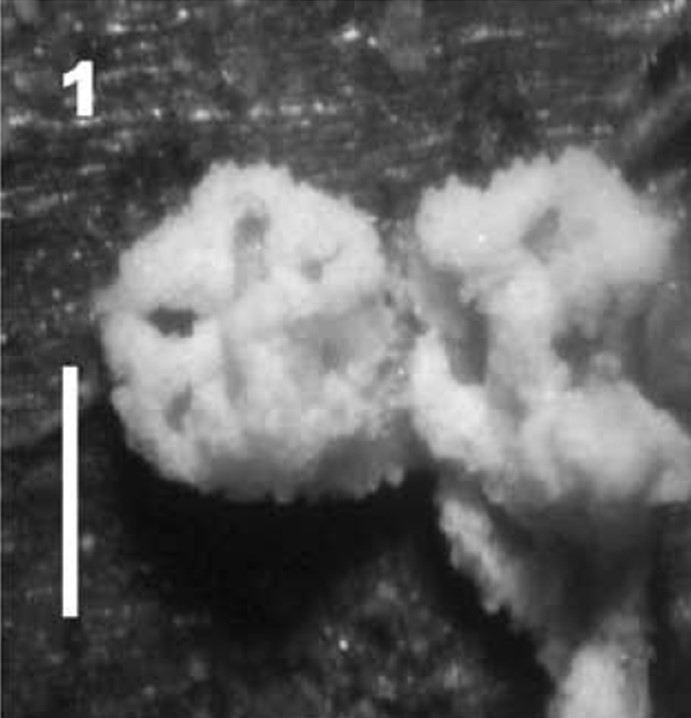- Proposed
- Under Assessment
- Preliminary Assessed
- LCAssessed
- 5Published
Favolaschia singeriana Dennis
- Scientific name
- Favolaschia singeriana
- Author
- Dennis
- Common names
- IUCN Specialist Group
 Mushroom, Bracket and Puffball
Mushroom, Bracket and Puffball- Kingdom
- Fungi
- Phylum
- Basidiomycota
- Class
- Agaricomycetes
- Order
- Agaricales
- Family
- Mycenaceae
- Assessment status
- Assessed
- Preliminary Category
- LC
- Proposed by
- Roberto Garibay Orijel
- Assessors
- Roberto Garibay Orijel
- Editors
- Roberto Garibay Orijel
- Contributors
- Lilia Pérez Ramírez
Assessment Notes
Favolaschia singeriana is a tiny sessile fungi associated to ferns in tropical ecosystems in the Neotropics. It has been registered just three times in 65 years. However, given its wide habitat potential and geographic distribution there should be numerous unknown subpopulations with many individuals each.
Justification
Just with three collections the species has a EOO of 1,685,456 km2 so the species fits the Less concern category.
Taxonomic notes
Favolaschia singeriana is a small, inconspicuous, resupinate, discoid, pruinose, white basidiomycete.
There are four Favolaschia species associated to ferns: F. alsophila Singer, F. singeriana, F. peziziformis (Berk. & M. A. Curtis) Kuntze, and F. pterigena Singer.
F. singeriana is distinguised from the other species by the spores size (7–10.5 × 4.5–7.5 μm) and small basidiomata (up to 1 mm).
Why suggested for a Global Red List Assessment?
Favolaschia singeriana is a tiny sessile fungi associated to ferns in tropical ecosystems in the Neotropics. It has been registered just three times in 65 years. However, given its wide habitat potential and geographic distribution there should be numerous unknown subpopulations with many individuals each.
Just with three collections the species has a EOO of 1,685,456 km2 so the species fits the Less concern category.
Geographic range
The Neotropics, from Mexico to Colombia and Venezuela
Population and Trends
F. singeriana is a very rare small inconspicuous fungi only recorded three times in the Neotropics in 65 years. Given that it is associated to several tropical ecosystems in a wide EOO = 1,685,465 km2 there is a high chance to exist many more undocumented subpopulations and current information do not allow to infer its population size.
Population Trend: Uncertain
Habitat and Ecology
It is a saprotroph of fern leafs in tropical rain forest and mountain cloud forest.
Threats
Even while tropical forests and Mountain cloud forests are threatened by global warming and deforestation, F. singeriana associates to both ecosystems that currently have wide distribution in the Neotropics. The species is threatened in this moment.
Conservation Actions
Global warming mitigation, habitat conservation
Research needed
Search for more subpopulations and current distribution of the species.
Use and Trade
any
Bibliography
Medel, R., Lorea-Hernández, F., & Guzmán, G. (2010). Fungi growing on Mexican tree ferns II. First record of Favolaschia singeriana (Agaricales, Marasmiaceae). Nova Hedwigia, 50(91).
Dennis, R.W.G. (1952). The Laschia Complex in Trinidad and Venezuela. Kew Bulletin, 7(3), 325-332. Published by: Springer on behalf of Royal Botanic Gardens, KewStable URL: https://www.jstor.org/stable
Singer, R. 1974. A monograph of Favolaschia. Nova Hedwigia 50. J. Cramer, Lehre
Country occurrence
Regional Population and Trends
| Country | Trend | Redlisted |
|---|

